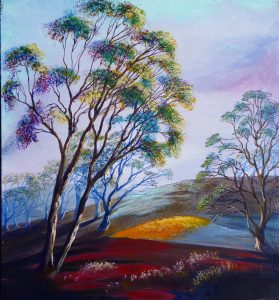 About Eli Sky
About Eli Sky
I’ve had a life-long interest in art and making art since childhood. In recent years I’ve had the good fortune to study art with some of Australia’s leading artists – Stephen Buntrock, Hobie Porter, Marcel Desbiens.
Member and newsletter editor Royal Queensland Art Society Gold Coast, 2021 – present.
My art and life have been influenced by the beauty of nature, art throughout the ages, religious traditions, psychology, philosophy, archaeology – humanities in general. I also have a life-long love of science eg ecology, astronomy, physics, chemistry.
My work career included: laboratory assistant, logic tutor, plant nursery owner/horticulturist, potter, psychologist (29 years registered psychologist, 17 years forensic psychologist), 32 years working with abuse – survivors and perpetrators.
Of my many loves the natural world on planet earth and beyond take precedence. Carl Sagan is one of my heroes. He requested astrophysicists at NASA to turn Voyager 1’s camera around to photograph the earth from the edge of our solar system at a distance of 3.7 billion miles away. Result – a pale blue dot in a beam of coloured light. This iconic photograph is a reminder of our smallness, insignificance, futile posturing, vain power grabbing and pointless violence towards one another and the natural world on this beautiful ‘pale blue dot’. The ‘Pale blue dot’ speech by Carl Sagan could change your life!
The grandness of nature, the vastness and magnificence of the universe, the extraordinary beauty of life, energy and matter, as well as the amazing and useful laws and theories that scientists have revealed can give us a cosmic perspective and global standpoint on everything we do. We are small but we can do great things during our short span on our pale blue dot, planet earth. Nature, science, art provide ways of immersing ourselves in the beauty, marvels and mysteries of the natural world and human life to appreciate what is here, our place and how we can honour and value it all.
University Education
Bachelor of Divinity (Eastern & Western Religions) University of Queensland, St Lucia
Bachelor of Arts (Philosophy) University of Queensland, St Lucia
Diploma in Social Science (Psychology) University of New England, Armidale
Honours in Psychology University of Queensland, St Lucia
Master of Education (Adult & Workplace), Queensland University of Technology, Kedron.
Painting teachers
Jonas Statulevicius (deceased), Stephen Buntrock (Gold Coast Art School), Hobie Porter (Artable Art Retreat Tyalgum), Fiona Graham (Artable Currumbin), Marcel Desbiens (McGregor Summer Visual & Creative Art Retreat USQ), Heather Bell (Kirra Community Centre).
Ceramics education: Southport TAFE ceramics 2 year course (1984-1985); Flying Arts Glaze Course (1985-1986).
About Art
Our ancient ancestors probably had similar sensibilities to us, enjoying singing, dancing, playing musical instruments, painting, sculpting, making adornments, designing, building and embellishing structures, observing and experimenting with reality. Like us today they belonged to groups: families, tribes, clans, communities, societies, civilizations. People developed ways such as art to express their ideas about being alive, their feelings about themselves, nature and the world, their place in it, beauty, goodness and conceptions of the Divine. Art, in all its forms, conveys what we value, our ways of belonging, our epoch in history and is one record of human existence.
Non-hominid animals don’t non-functional make art. Some of them did and do use tools just like hominids who began to make and use stone tools over two million years ago. Stone tools were practical things to sustain basic survival needs. Over time the tools made by hominids were embellished with designs – early art. Our very ancient ancestors painted in caves, cut designs into stone that have survived thousands of years. In Australia there are geoliths (shapes cut into stone all over the country) estimated to be over 60 thousand years old. Humans love to create.
Art goes beyond survival needs, speaking to the heart, soul and mind connecting people to one another and to reality around and beyond themselves. People created beads for adornment, figurines to celebrate, propitiate or record something important, cave paintings depicted animals, a hunt, feast, meetings, victory, everyday life. Dances, music, poems, plays, writings tell stories, entrance, touch emotions, exert power and control, convey a world view, or tease, shock, humour, please and open us to new ideas and worlds and feelings. Visual art can express what language and physical gestures can’t. Art requires imagination to conjure up something that wasn’t there before. Human imagination allows us to make art and to innovate. It is as natural as breathing, cooking, growing food, commerce, building and making practical things for daily life.
Peering into the world of our hominid ancestors through their art we may wonder what they were thinking, feeling and doing. When we see paintings from the 20th century onwards we see a proliferation of art styles as never before. Different thoughts and feelings are evoked by pre Raphaelite paintings in contrast with the paintings of Van Gogh, Kandinsky or Rothko. People respond to different kinds of art. At this time in history we are fortunate to have so many styles to appreciate or use in our art practice.